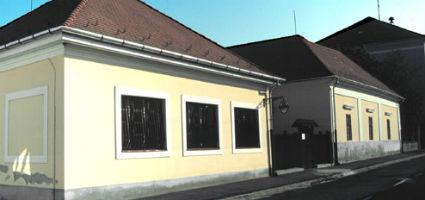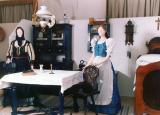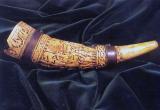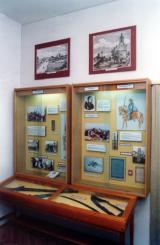2025. July 3. Thursday
Jász Museum - Jászberény
 |
Address: 5100, Jászberény Táncsics Mihály u. 5.
Phone number: (57) 502-610
E-mail: jaszmuzeum@gmail.com
Opening hours: 01.11-31.03.: Tue-Fri 9-16, Sat-Sun 9-13
01.04-31.10.: Tue-Fri 9-17 |
In Jászberény, former chief town of the Jazygian - Cumanian District, arose the idea - among the first in the country - to establish a museum. Deputy mayor, Orban Sipos stressed the significance of the idea to place the Jazygian relics in a worthy place, so the succeeding generations may look back upon their history. The museum of the Jazygians, which had been placed in one of the Town Hall's courtyard buildings, opened its gates to the public on 24th December 1874. The gradually increasing collection had been moved to one place and another Jazygian Horn Inn (Jászkürt Fogadó), District Headquarters (Kerületi Székház), Town Hall (Városháza) up until 1931, when they found permanent place for the museum, the empty horsestable of the Town Hall. The museum has been running ever since, in the classical building, with Dorian pillars, and has been steadfastly collecting written and objective documents of the Jazygians here since 1842.
During the past 130 years many directors had done tremendous work for the istitute. The museum's first 'guard' was János Ozoróczky, at the turn of the century, though Viktor Hild, antiquity expert, took care and enlarged the collection. Professor of archaeology, János Banner represents a crucial period in the history of the museum. He had been head of the institute for seven years from 1913. During his mandate the everydays of the institute started to sparkle. He expanded the museum's collecting areas into the fields of ethnography, and established a modern recording process for the collections. In 1926 Kálmán Réz retired vicar was appointed to take over the museum, who did a very good job by relating to the subject with enthusiasm, and also by popularizing the institute. A research staff of local history emerged around him (János Blénessy, József Porteleki, Ferenc Német, József Komáromy) whose activities started a new era in terms of the local history of the Jazygian region.
From 1950 major changes were at issue, namely, the state put its hands on the museum to make it one of the member museums of the County Museum Organization (Megyei Múzeumi Szervezet). It was József Komáromy who became director of the administratively newly formed institute followed by archaeologist, József Csalog. During this period the number of archaeological relics grew, whilst the ethnographical collection had been enlarged afterwards by Sándor Erdész and István Halmos. In 1958 János Tóth became head of the Jazygian museum and filled this position for 36 years. During these years the collections of local history, ethnography, natural science and industrial history had enlarged quite extentively, moreover a new wing had been atteched to the building alongside with a new warehouse. He also launched the Jazygian Booklets (Jászsági Füzetek) series, which has been very widely read ever since, and the research staff of local history had been united also by him.
The new director introduced further changes in the life of the museum in 1994. Major renovations were carried out and successful results came out of the trade alterations, which made this period also as significant as the above mentioned. The Jazygian Museum Foundation (Jász Múzeumért Alapítvány) established in December 1994 gave way for further publications and also provided the opportunity for permanent exhibitions. The museum launched its new paper called Redemption (Redemptio), which is widely read throughout the country.
During the past 130 years many directors had done tremendous work for the istitute. The museum's first 'guard' was János Ozoróczky, at the turn of the century, though Viktor Hild, antiquity expert, took care and enlarged the collection. Professor of archaeology, János Banner represents a crucial period in the history of the museum. He had been head of the institute for seven years from 1913. During his mandate the everydays of the institute started to sparkle. He expanded the museum's collecting areas into the fields of ethnography, and established a modern recording process for the collections. In 1926 Kálmán Réz retired vicar was appointed to take over the museum, who did a very good job by relating to the subject with enthusiasm, and also by popularizing the institute. A research staff of local history emerged around him (János Blénessy, József Porteleki, Ferenc Német, József Komáromy) whose activities started a new era in terms of the local history of the Jazygian region.
From 1950 major changes were at issue, namely, the state put its hands on the museum to make it one of the member museums of the County Museum Organization (Megyei Múzeumi Szervezet). It was József Komáromy who became director of the administratively newly formed institute followed by archaeologist, József Csalog. During this period the number of archaeological relics grew, whilst the ethnographical collection had been enlarged afterwards by Sándor Erdész and István Halmos. In 1958 János Tóth became head of the Jazygian museum and filled this position for 36 years. During these years the collections of local history, ethnography, natural science and industrial history had enlarged quite extentively, moreover a new wing had been atteched to the building alongside with a new warehouse. He also launched the Jazygian Booklets (Jászsági Füzetek) series, which has been very widely read ever since, and the research staff of local history had been united also by him.
The new director introduced further changes in the life of the museum in 1994. Major renovations were carried out and successful results came out of the trade alterations, which made this period also as significant as the above mentioned. The Jazygian Museum Foundation (Jász Múzeumért Alapítvány) established in December 1994 gave way for further publications and also provided the opportunity for permanent exhibitions. The museum launched its new paper called Redemption (Redemptio), which is widely read throughout the country.


